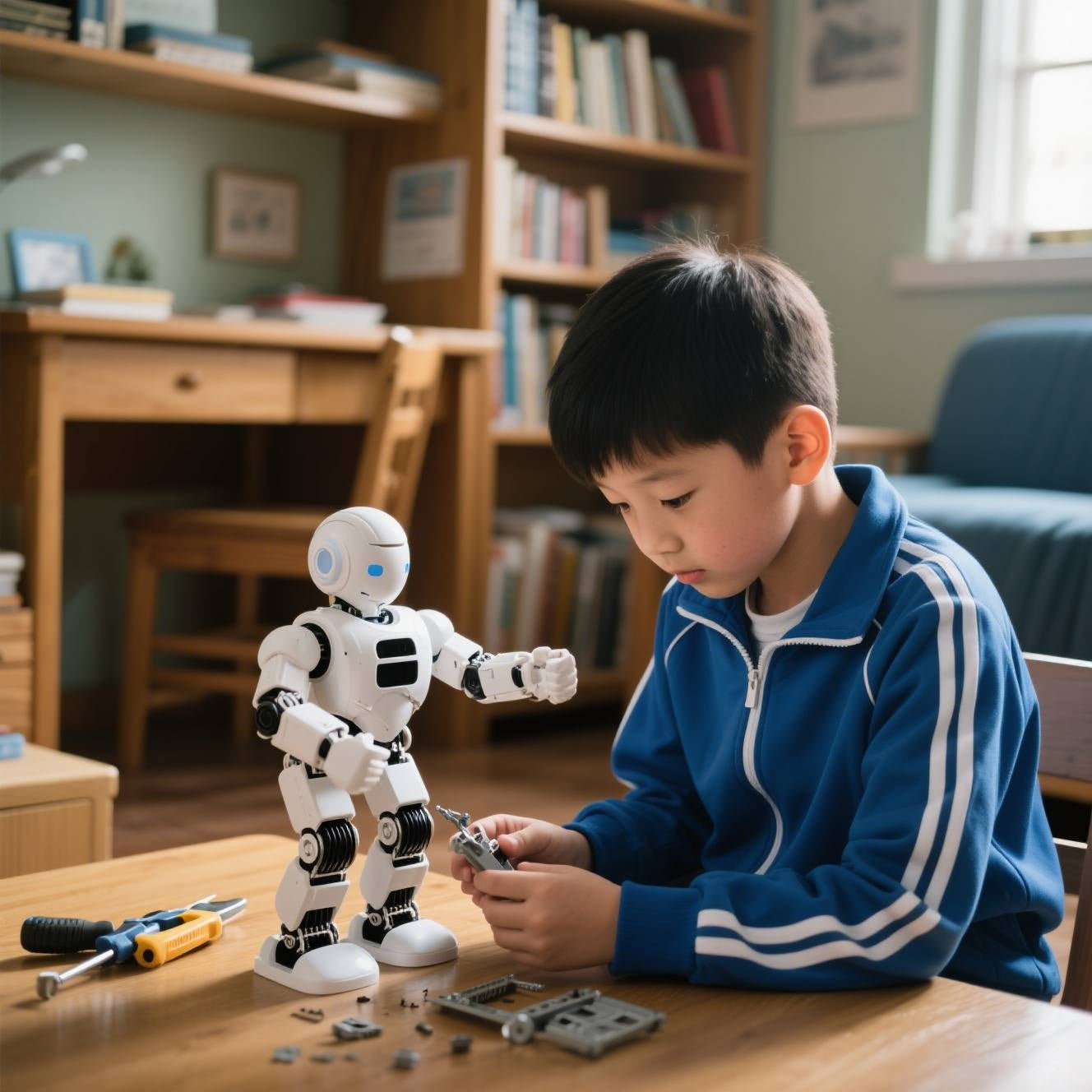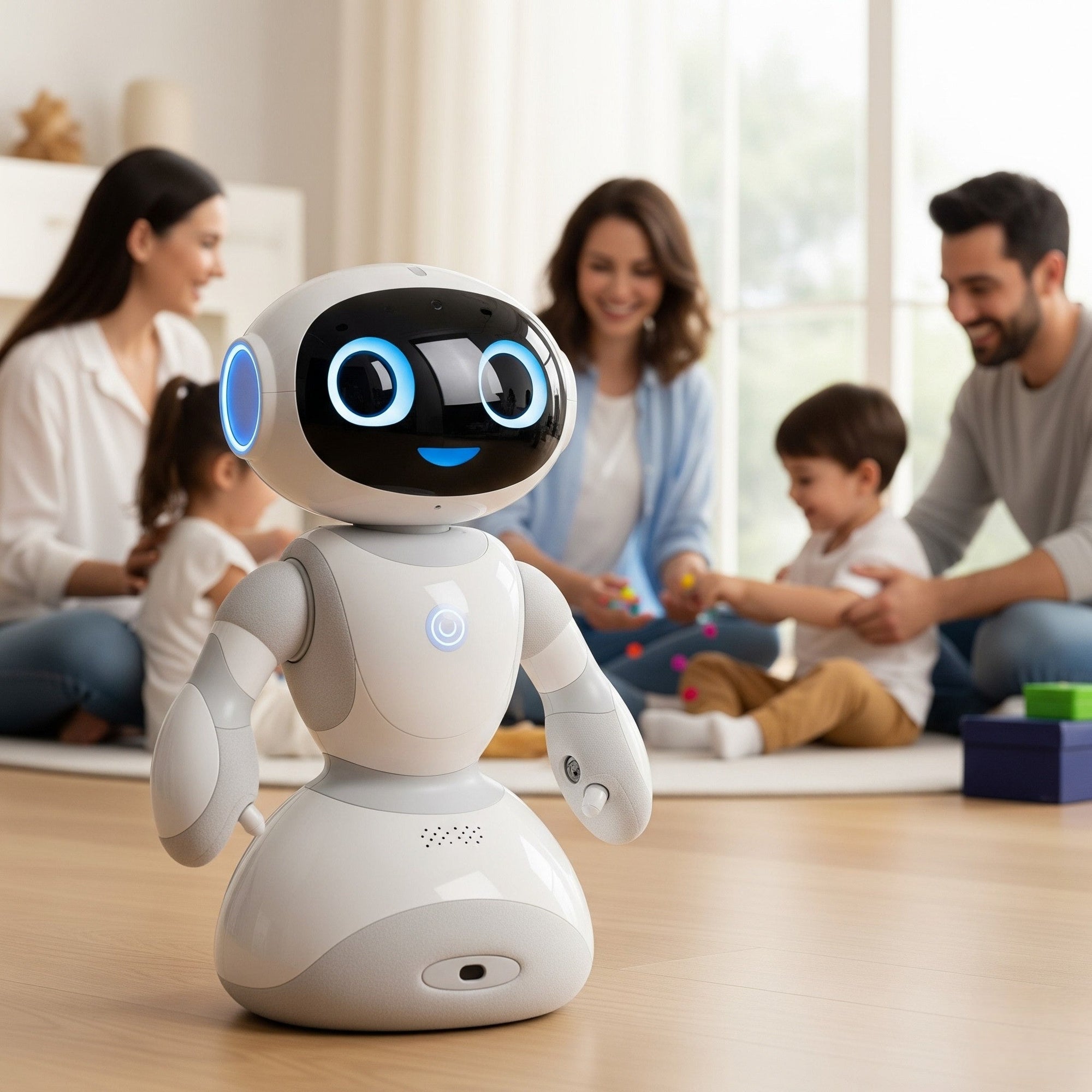Want pet companionship without the hassle? Life-like dogs robots offer just that. Technology makes this possible.
Maybe you're allergic, your place bans pets, or you just want an easy-care pal. Robot dogs are a clever answer. They range from cute, interactive toy dogs that bark and walk like real dogs to advanced companion robot dogs for anxiety. We'll help you find the right one.
Types of Dog-Like Robots
Dog-like robots come in various forms, catering to different needs and preferences. Here's a breakdown of the main categories:
| Key Feature | Characteristics | Suitable For |
|---|---|---|
| Mimicry | "Realistic movements (walk, run, sit) Dog-like sounds (bark, whine) Expressive eyes/body language" |
Children |
| Interaction | "Sensors (touch, sound, light) Responds to commands Interactive play (fetch, dance)" |
"People with allergies No-pet housing Elderly/dementia patients" |
| Maintenance | "No food, water, walks, or cleaning No allergies or shedding Durable materials Battery-powered and portable" |
"Busy individuals/families ""Trial run"" for real pet Seeking companionship" |
Robot Dog that Acts Like Real Dog Product Recommendations
For those looking for fun and entertainment, realistic dog stuffed animals and toy robot dogs are a great choice. These are typically simpler in design and functionality but can still provide hours of joy, especially for children.
Dog-E Interactive Robot Dog

Image source: Dog-E Interactive Robot Dog
-
Interactive Play: Dog-E offers over 200 interactions and 6 games, including tug-of-war with its magnetic bone toy, and responds to petting and feeding.
-
Realistic Movements & Sounds: It moves and sounds like a real dog, with a cute forward run, wagging tail, and over 200 distinct sounds and reactions.
-
Tail Communication: Dog-E communicates its needs (food, affection, games) through its tail using innovative Persistence of Vision (POV) technology, displaying emotes, icons, and messages.
-
App-Enabled Care & Training: A companion app allows users to track Dog-E's needs, feed it, throw treats, train it to learn names and tricks, and save multiple profiles for different family members.
Purchase channel: Amazon、Macys、TARGET、Bestbuy、Walmart. Price range: US$39.99-US$67.99.
Contixo Smart Puppy

Image source: Contixo R3 Interactive Smart Robot Pet Dog
-
Interactive Play: Responds to touch commands and remote control for engaging interaction.
-
Diverse Tricks & Movements: Capable of performing various tricks and exhibiting realistic, playful actions.
-
Engaging Sensory Experience: Features bright LED lights and sound effects for an immersive play experience.
-
Safe, Portable & Ideal Gift: Built with durable, kid-safe materials, easily portable, and makes a perfect gift for young children.
Purchase channel: Official website or third-party platforms such as Amazon. Price : US$35.99.
Top Race Dancing Dog
-
Interactive Play: This robot dog walks, dances, barks, and responds to voice commands, fostering social interaction and creativity in children.
-
Educational Programming: Kids can program the robot, learning basic coding and developing logical thinking, problem-solving, and motor skills.
-
Durable & Rechargeable: Designed for active play, it has a rechargeable battery for continuous fun without constant replacements.
-
Customizable Entertainment: With 12 voice commands, 10 animal imitations, and a 7-function remote, it offers diverse and engaging activities.
Purchase channel: Amazon、TARGET、eBay、Walmart. Price : US$44.99.
Interactive Companions Product Recommendations
These robot dogs are not just toys, but companions that provide emotional value. They use artificial intelligence to respond to you, learn and show emotions, which can interact with you and bringing fun.
| Main Functions | Price Range | User Groups |
|---|---|---|
| Emotional Support & Therapeutic Benefits | $100 - $500 for basic models $2,000 - $7,000+ for advanced AI models |
Seniors/Elderly, Individuals with Disabilities, People with Allergies, Individuals with Anxiety, Depression, PTSD, Children with Autism |
| Education & STEM Learning | $100 - $500 for beginner models higher for advanced programmable kits |
Children & Students, used as teaching tools. |
EMO by LivingAI
-
1000+ Expressions & Fun: He dances, plays games, and reacts to music.
-
Self-Navigating Whiz: Packed with sensors, Emo maps rooms, tracks sounds, recognizes people/objects, and avoids falls.
-
Evolving Character: Emo’s personality changes based on your interactions.
-
Useful Daily Tasks: He’ll wake you, control lights, snap pics, and answer questions.
-
Smart Senses: HD vision, 4-mic hearing, touch sensitivity, and a learning AI brain make interactions feel real.
Purchase channel: Official website or third-party platforms such as Amazon. Price range: US$279-US$379.
Loona Petbot (KEYi Robot)
-
Navigation and Charging: Loona learns the best path back to her charger and and learns new routes you create.
-
Plays Like a Real Pal: With HD camera, Loona recognizes faces, reads gestures, and plays fetch.
-
Chatty Companion: Ask questions or chat naturally. Powered by smart AI (keeping your data safe), she talks back!
-
Games Galore: Chase laser dots, fetch toys, or play app games and quizzes – endless ways to play.
-
Home Guardian: Use camera and speaker to monitor your space from anywhere.
Purchase channel: Official website or third-party platforms such as Amazon. Price range: US$399.9-US$500.
Makeblock mBot2

Image source: Makeblock mBot2: STEM Education Coding Robot Kit for AI Learning
-
AI Exploration: Kids command mBot2’s moves, sounds, and lights through fun AI games.
-
User-Friendly Design: Quick assembly with visual guides. Offer Intuitive app with block coding and play modes.
-
Full Coding Path: Start with Scratch, grow into Python. Master robotics and game design.
-
Upgradeable Tech: Over 10 advanced sensors and can be expanded with 30+ modules for IoT or collaborative bots.
Purchase channel: Official website or third-party platforms such as Amazon. Price range: US$159.99.
AI-Powered Robots
These cutting-edge robot dogs mimic real pets by learning and adapting. Still in labs for now, but they show how future robo-pets could behave like actual dogs.
University of California, Berkeley's Robot Dog
Using reinforcement learning, this robot taught itself to walk in just one hour, demonstrating the potential of AI in robotics. It learned to flip over, stand, and walk without simulation, adapting to real-world conditions (MIT Technology Review).
MIT's Robot Dog
Trained entirely on synthetic data, this dog can navigate complex terrains like stairs and boxes, showcasing how simulations can bridge the gap between virtual and real-world learning (Singularity Hub).
IntuiCell's Luna
This autonomous robot dog learns to walk and move like a human, using a digital nervous system that mimics biological learning processes. It’s still in development but shows promise for adapting to unpredictable environments (Reuters).
While these AI-powered dogs are not yet commercially available, they highlight the rapid advancements in the field and what we might expect in the near future for life-like dogs.
Features to Look For
When choosing a dog-like robot, consider the following features to ensure it meets your expectations:
| Feature | Description | Examples |
|---|---|---|
| Realism | Look for soft fur, realistic sounds, and lifelike movements to mimic a real dog. | Tombot Puppy’s recorded puppy sounds, Joy for All’s heartbeat feature. |
| Interactivity | Check for voice command response, touch sensors, or app-based customization. | metaDog’s voice recognition, Tombot’s touch sensors. |
| Durability | Ensure it’s built to withstand frequent handling, especially for kids or seniors. | Joy for All’s stain-resistant fur, metaDog’s simple cleaning requirements. |
| Battery Life | Evaluate operation time and charging ease for uninterrupted use. | metaDog’s 10-hour battery, Tombot’s all-day use after overnight charging. |
| Price | Balance cost with features; prices range from $50 to over $300. | Top Race Dancing Dog ($50), Tombot Puppy ($299+). |
Top Picks
Here are some top recommendations based on different needs:
-
Best for Seniors: Joy for All Companion Pet Pup – Its design focuses on providing comfort and companionship, with features like a heartbeat and responsive interactions. Studies cited on the Joy for All website show it reduces loneliness and improves quality of life (Joy for All).
-
Best for Companionship: metaDog or Tombot Puppy – Both offer advanced interactivity and realistic behaviors, making them ideal for those seeking a true companion. Tombot’s Jennie is particularly noted for its therapeutic benefits for dementia and anxiety (Tombot).
-
Best for Children: FurReal Friends Pax – With its fun poop function and interactive play, it’s engaging for kids while teaching responsibility (Amazon).
FAQ
Are robot dogs good for children?
Yes, robot dogs can be great for kids. Many models are designed to be safe and engaging for children. Just be sure to follow the age guidelines and watch little ones while they play.
How long do robot dogs last?
Basic/toy robot dogs usually have a service life of 1 to 3 years. Mid- to high-end consumer robot dogs (such as Loona and Aibo) can have a service life of 5 years or even longer if properly maintained. Industrial/advanced quadruped robots (such as Unitree and Boston Dynamics Spot) may have a service life of more than 5-10 years.
Many factors affect the life of the robot dog, which can be summarized into the following four points:
-
Build Quality: Better made robots (like expensive ones) last longer. Cheaper toys break faster.
-
Battery Life: All batteries get weaker over time. If you can change the battery, the robot lasts longer.
-
How Often You Use It: Using the robot a lot, or if it falls often, makes it wear out faster.
-
Fixes & Updates: If you can get parts or software updates, the robot will stay useful longer.
Can robot dogs be programmed or customized?
It depends! Higher-end robot dogs like metaDog and Tombot Puppy offer app-based customization. Name your pet or train it to learn tricks. More basic models like FurReal Friends Ricky have fixed actions but can still pick up simple commands.
Are there robot dogs that can go outside?
Keep ’em inside unless the specs say otherwise. Weather can wreck cheaper models. Fancier outdoor bots cost more and aren’t common. Never skip checking the owner’s manual.
What is the price range for robot dogs?
Robot dogs run from $50 for simple toys to $500+ for smart companions. You’ll pay more for advanced features – but get smarter interactions.
Do robot dogs require much maintenance?
Robot dogs need very little upkeep. Just wipe them down now and then, and keep their batteries fresh. That’s usually all it takes!
Can robot dogs help with anxiety?
Absolutely. Companion robot dogs for anxiety are designed for companionship and help with anxiety. Their presence and responsiveness provide genuine comfort during stressful times.
Conclusion
Whether you want a simple stuffed robo-dog or a dog-like robots emotional support companion, realistic dog stuffed animals fit all needs. Great for gifting children, supporting seniors, or being your own unique low-maintenance buddy.








